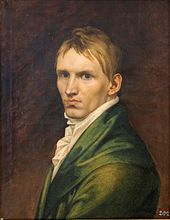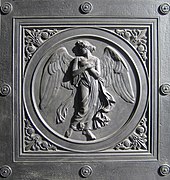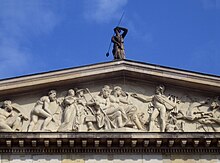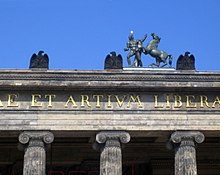Christian Friedrich Tieck
Christian Friedrich Tieck (born August 14, 1776 in Berlin ; † May 12, 1851 there [according to another source on May 24, 1851]) was a prominent representative of the Berlin school of sculpture at the time of the 19th century. His extensive oeuvre, not limited to Berlin, includes numerous portrait sculptures . But he also made significant contributions to the design of several buildings by the classicist architect Karl Friedrich Schinkel , primarily for his Royal Theater on Gendarmenmarkt , today's Konzerthaus Berlin .
Life
School and apprenticeship
Tieck was born as the third child of a family of craftsmen on Roßstrasse (today Fischerinsel in Berlin-Mitte ). The father, a master rope maker, was an unusually well-read man for his profession; he had a small house library in which the writings of the Enlightenment were also stored . The parents made sure that their sons - Christian Friedrich as well as his older brother Ludwig , who later became famous writer - could attend the Friedrichswerder high school in Berlin. As a student, Tieck was not particularly successful. On the other hand, his talent for visual design emerged early on. His parents took him out of school early and in 1789 apprenticed him to the sculptor Heinrich Bettkober for six years . There he received lessons in drawing, the formation of three-dimensional images and the craft of stone processing. In addition, at the age of fifteen he was already drawing at the Akademie der Künste , which was then headed by Johann Gottfried Schadow , and towards the end of his apprenticeship he won a medal there for the replica of an ancient sculpture . After completing his apprenticeship, he worked as a master student in Schadow's studio, which gave him lasting support. The first successful portraits are known from 1796, including those of his siblings Sophie and Ludwig and of Ludwig's school friend, the writer Wilhelm Heinrich Wackenroder, who died early .
Travel years
Paris, Weimar, Jena
Following the intercession of Schadow and Wilhelm von Humboldt , Tieck received a small grant from the royal court for a study visit to Italy. With Humboldt and another companion, he traveled to Vienna via Dresden in 1797. The actual destination was no longer attainable because of the Napoleonic campaigns in Upper and Central Italy, so the three drove instead via Munich to Paris, where they arrived in January 1798. There Tieck continued his education in the studio of the painter Jacques-Louis David - drew and painted, copied Greek and Roman models and modeled various portrait busts. In the autumn of 1800 he was successful with a relief - Priam asks Achilles for the corpse of Hector - in the competition for the Grand Prix of the École des Beaux-Arts in Paris. According to the statutes, a foreigner was not allowed to receive the first prize, so it was not awarded and Tieck received the second. After this success people became aware of him in circles interested in art.
Through Humboldt's mediation, Tieck came to Weimar in late summer 1801 . He first created a somewhat idealizing bust of Goethe - in the judgment of his wife Christiane "the best that we have so far from the Privy Council". Goethe wanted to use the young sculptor's proven talent to design the new palace in Weimar and discussed the extensive project with him. In nearby Jena , Tieck met the Schlegel brothers, friends of his brother Ludwig. Caroline , the wife of the older of the two, August Wilhelm Schlegel , described the guest in a letter dated November 16, 1801: “He walked away from us ... in his shabby skirt, which no longer rubs a hair when you drive over it (between us, I tried it…) with a stick, in my pocket nothing but a roll of paper that peeked out for a long time… very thin, and the blond hair fluttering in his face. "And on December 10th, 1801:" Amiable enough - if not imposing, is it? He's an easy, but I believe honest nature, nothing of the pitfalls of the other (was meant by Friedrich Tieck), more visible vanity, everything harmless, less reflection, thank God, and almost a denser talent. "
Tieck spent the winter of 1801/02 in Berlin again, where he received and successfully executed at least six orders for portrait busts. He refused to work on a portrait of Queen Luise because he did not want to compete with his teacher Schadow, who had created a single bust of Luise around 1795 and the famous group of princesses of the sisters Luise and Friederike in 1797 . In April 1802 Tieck returned to Weimar to carry out the pictorial program agreed with Goethe in the city palace of the Grand Duke of Saxe-Weimar-Eisenach , as well as a whole series of portraits. These numerous works finally established Tieck's reputation among his contemporaries. In February 1803 a short, violent love affair began in Weimar between Tieck and the successful novelist Charlotte von Ahlefeld , who was still married at the time .
Rome, Munich, Carrara
In 1803 Tieck stayed temporarily in Berlin, where he did various portrait assignments. In 1805 he traveled via Vienna to Munich and now finally to Italy. The Academy of Arts awarded him a scholarship for a two-year stay. He reached Rome in August 1805, studied the classical models intensively during this first stay in the city, but soon also accepted commissions and modeled a number of portraits, including the bust of Alexander von Humboldt , who had just returned from America. In the spring of 1809 he came to Munich via Switzerland, where his siblings were staying, and there he also worked on various portrait sculptures. One of his models was the philosopher Friedrich Schelling , whose wife Caroline, meanwhile divorced from Schlegel and married to Schelling, now stated in a letter dated March 1, 1809: “From there one expects the sculptor Tieck, whom I usually think of as the most nimble of held by his siblings, but now seems to me to be the most solid, because he lives on what he acquires and only borrows for his sister. His first work will be Schelling's bust, which he has wanted to make on his own for a long time, but now the Crown Prince wanted it for his collection… ”. An important event for Tieck in Munich was the large order for a number of marble busts for the so-called " Walhalla ", a temple-like structure near Regensburg that was only planned at the time and in which outstanding personalities were to be honored for their services to Germany .
In 1811 Tieck returned to Rome. There he met the Berlin sculptor Christian Daniel Rauch , who had learned from Schadow a few years after him. Tieck and Rauch had a joint workshop in Rome and a second at the marble quarries of Carrara . In this second workshop, Tieck began working on the Walhalla portraits, but also helped his colleague Rauch to complete his famous sarcophagus for Queen Luise. Rauch left Italy in 1813. Two years later he campaigned for Tieck to be offered the post of director of the sculpture department at the Art Academy in Düsseldorf , then Prussia . However, Tieck refused and wrote to Rauch: “You know how I hate all professors, twice those of a provincial academy. To go there would mean never wanting to do anything again ”. The main reason for the rejection of such an honorable job, however, was that Tieck hoped he could earn more money in Italy. Because he had been making a living for his divorced, destitute sister since 1804 and she took advantage of his courtesy without hesitation, he was constantly in debt. Tieck stayed in Italy, but kept in close correspondence with Rauch, who was in great demand as a sculptor in Berlin. A concrete professional perspective arose in 1818. The National Theater on Gendarmenmarkt in Berlin, only opened in 1802, was burned down to the outer walls in 1817. Karl Friedrich Schinkel was commissioned to rebuild it on the old floor plan and wanted Tieck as an employee. Rauch then wrote to Italy: "Schinkel instructs you to collect nice ideas, to decorate a music hall with several statues and many unrelated bas-reliefs ...".
Back in Berlin
On April 29, 1819, Tieck arrived in Berlin, four experienced assistants from Carrara accompanied him. He shared his workshop with Rauch in the so-called warehouse and took part in several jobs that Rauch was working on. The employment relationship was not always free from tension. In the meantime Rauch was not only more famous than his teacher Schadow ("My fame went up in smoke" is said to have complained), but also as Tieck - with whom he always remained on friendly terms. An example of the collaboration between the two was the National Monument for the Wars of Liberation on Berlin's Kreuzberg (at that time still Tempelhofer Berg and located well outside the city gates) based on a design by Schinkel. The tomb for General Gerhard von Scharnhorst on the Invalidenfriedhof in Berlin was also a joint effort : the overall design was by Schinkel, Rauch modeled a resting lion and Tieck modeled the reliefs on the base. In 1820 Tieck was appointed professor at the Prussian Academy of the Arts, and at the same time also appointed to the academic senate. His very own large project was the sculptural design of the theater on Gendarmenmarkt, a work that he began soon after his return from Italy and that lasted over thirty years with interruptions until shortly before his death.
In the meantime, a considerable number of individual works of greater or lesser importance were created, including numerous portraits - including by Friedrich August Wolf , Rauch and Schinkel as well as a bust by Friedrich Gottlieb Klopstock for a memorial in his birthplace Quedlinburg - a statue of the King Friedrich Wilhelm II for the city of Neuruppin , an eagle for the Kaiser Joseph II monument in Brno and 15 half-life-size figures for the tea room of the royal palace in Berlin, only two of which have survived. Late works were a statue by Schinkel, which remained unfinished and was only completed after the sculptor's death, and a Nicolaus Copernicus monument for the city of Thorn . Although this is called Tiecks, he hardly worked on it himself. His contributions to other buildings by Schinkel in Berlin were more significant. He designed the 20 relief medallions for the cast-iron double doors of the Friedrichswerder Church, which was completed in 1830, and provided important sculptures for the construction of the Altes Museum , which was called the Neues Museum until 1845 and is considered Schinkel's main work alongside the theater. From 1830 to 1851 he also served as the director of the sculpture and plaster cast collection .
Not much is known about Tieck's personal life. His late marriage took place in a way that was seen partly as tragic, partly as scandalous: as a prominent 70-year-old, he married a 20-year-old from a wealthy family. This was done through the mediation of a creditor, with whom Tieck hoped to pay off his high debts in this way - in addition, a success fee of 2000 thalers was agreed. The in-laws found out about the agreement and immediately blocked all of their daughter's earnings, and shortly afterwards the marriage was divorced. Unlike his friend Rauch, Tieck was rarely given larger orders by the royal court. He died lonely and embittered on May 12, 1851. Rauch noted this in his diary: "Monday evening ½ 12:00 ended at a peculiar weakness him for years to work inactive [disabled =] made that much time friend and workshop Comrade Professor Fr Tieck ... What his indolence, work shyness and the burden of debt have made of him in recent years, in which he ends his days in every term of excessive humiliation, external hardship and misery, I leave to others forbearance and enlightenment. "
The main works
Weimar
Tieck has always been a hardworking, fast worker. In Weimar he outdid himself and delivered an astonishing number of works of art in a short period of time during several stays. For the city palace - which had largely burned down in 1774 and was rebuilt under Goethe's supervision - he created three large reliefs in the stairwell, a series of small reliefs for the Doric frieze of the stairwell, eight more for the Hereditary Grand Duchess' room, four statues for the niches of the Staircase and four life-size figures for the social room; In addition to the glorification of the ruling house, the works mainly show scenes from the mythology of ancient Greece: Elektra mourns Orestes , Heracles leads Alceste from the underworld , Antigone leads Oedipus , Omphale wreaths Heracles and similar motifs. In addition, at least twelve portrait busts of prominent personalities were created in Weimar - the Grand Duke, the Grand Duchess and the Hereditary Princes, Clemens Brentano , Johann Gottfried Herder , Johann Heinrich Voss and others. In 1802 August Wilhelm Schlegel judged Tieck's portrait sculptures and his drawings of reliefs and statues: “Just as the gentle and pleasing prevail in his portraits and no size is arbitrarily enforced ... the sketches, on the other hand, reveal the artist's inclination towards the mighty and Bold; the drawing is often of coarse form, the expression is everywhere decided and peculiar, and the grouping itself I would like to call fixed and not at all. "
Valhalla
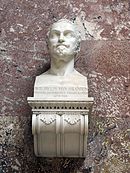
As early as 1807, as Crown Prince, the future King Ludwig I of Bavaria had planned the Hall of Fame , which was finally completed in 1842. Initially, 160 people were honored there with 96 portrait busts and, where that was not possible, with 64 memorial plaques (in 2007 there were 127 busts and 65 memorial plaques). Tieck made 23 of the portraits, most of them in 1812/13, some not until 1832, a single one in 1835. Among those portrayed by him are Moritz von Sachsen , Wallenstein , Bernhard von Sachsen-Weimar , Johann Philipp von Schönborn , (Elector of Mainz), Amalie Elisabeth von Hanau-Münzenberg , Moritz von Oranien , Ernst the Pious of Saxony, Karl V (Lorraine) , Gotthold Ephraim Lessing , Gottfried August Bürger , Herder, Goethe (with a replica of the Weimar bust from 1801 ), the Salier emperor Friedrich II. , August Neidhardt von Gneisenau , Rudolf I von Habsburg and Jan van Eyck . Tieck's friend and colleague Rauch, who followed the work, was convinced that Tieck's busts would be the most beautiful in “Walhalla”.
Playhouse
Schinkel's original idea of entrusting Tieck with the design of a music hall turned into a much larger order. The architect and sculptor worked closely together to develop an image program that referred to the world of ideas from classical antiquity - the main source for the imagery of classicism and Tieck familiar from many earlier works. In detail: depictions of the nine muses made of sandstone for the front as well as the south and north front of the theater; four large reliefs for the gable surfaces - two in front and one on each side; a figure of the Apollo in one of gripping drawn cart, in copper driven , as crowning roof figure on the front side; a pegasus also worked in copper on the reverse; 16 marble caryatids that adorned the concert hall and were destroyed in World War II. In a letter to August Wilhelm Schlegel, Tieck described the mythological scenes of one of the reliefs in detail and concluded: “Except for Orpheus and Cupid , the models are complete and most of the very colossal relief is made of stucco . Since I have very skillful people, things are done very well. ”The“ very skillful people ”primarily meant the sculptor Johann Balthasar Jacob Ratgeber, who converted Tieck's stucco models into sandstone.
The theater was inaugurated in May 1821, which was not the end of Teck's work. His statue of the actor and theater director August Wilhelm Iffland was created between 1824 and 1827 . When it was unveiled, it received extraordinary praise from theater-loving Berliners who had still known Iffland. The “Haude- und Spenersche Zeitung” wrote on January 28, 1828: “Iffland's marble statue, by the hand of our excellent artist Professor Tieck, is now installed in the vestibule of the concert hall and is a work that does its maker credit. The artist is shown in an antique costume, sitting on an antique armchair, with a slight upward movement of the similarly speaking head. The statue looks good with an appropriately placed drapery behind it ... and is an ornament of the room ”. After all, Tieck worked on the two striking bronze sculptures that stand on both sides of the large flight of stairs in front of the main facade for eight years . His theme here was the power of music, which can even tame wild animals : lions and panthers carry musical geniuses on their backs. The sculptor did not see the first public presentation of these sculptures on May 31, 1851.
Old museum
Schinkel planned several groups of figures on the roof of the museum in the first drafts of 1822/23. For the main front facing south, i.e. towards the Lustgarten and the Berlin City Palace of the Hohenzollerns , he envisaged two depictions of the Dioscuri Castor and Polydeukes (in ancient Rome Castor and Pollux), who tame their horses and gold, "in accordance with the style of the whole" Carry stars on their heads. The pair of brothers, always described in mythology as noble and chivalrous, stood as a symbol for the spirit of antiquity in a place which, according to the inscription, was dedicated to "the study of every kind of antiquity and the liberal arts".
The museum was built between 1825 and 1828. Tieck received the order for the Dioscuri in 1826. The model of the first group should be ready in October 1827, the second in March. Because time was pressing, Tieck was allowed to use the model of the first horse again, he only changed the posture of the head and the shape of a hoof. The sculptures, well over three meters high, were cast in the Königliche Eisengießerei Berlin , where a hollow casting process was developed that was also suitable for large workpieces. In October 1828 the statues were put together and attached to the cubic roof attachment of the Altes Museum. A multi-layered, translucent application of paint on the cast iron surface imitated the appearance of ancient bronze figures. During the Second World War, the Dioskuren - unlike the museum building as a whole - were only slightly damaged and repaired on site on the roof in 1962.In October 2005, they had to be temporarily removed due to severe corrosion damage and thoroughly restored in a special workshop . - For the former popularity of the Dioscuri groups speaks that from around 1830 scaled down reproductions were in circulation as paperweights.
The sandstone eagles, which are attached to the entablature above each of the 18 Ionic columns, to which the main facade of the museum owes its impressive appearance , also come from Tieck . - After the house opened in 1830, Tieck was appointed director of the sculpture collection that was housed here. He put together the first catalog of the collection and restored or added several of the ancient sculptures. Because of these activities he was sometimes referred to by friends as an “ antiquarian sculptor”.
The portrait art
The portrait busts in particular were the reason for Tieck's widespread reputation and at times gave him more jobs than he could handle. Contemporaries praised the characteristic portrayal of the respective individual , as well as the ability to give the portrayed more general traits of beauty and dignity. Christian Daniel Rauch confessed that he always tries to achieve the “grace and ideality ” in his own work that Tieck gave to his portraits.
One of his best-known portrait busts is the one for Friedrich Gottlieb Klopstock in the monument ensemble in Brühl in Quedlinburg, which was inaugurated in 1831 with the significant participation of Karl Friedrich Schinkel .
- gallery
Stallion Eclipse by Simon Moritz von Bethmann , 1812
literature
- Nina Struckmeyer: Tieck, Christian Friedrich . In: Bénédicte Savoy, France Nerlich (ed.): Paris apprenticeship years. A lexicon for training German painters in the French capital . Volume 1: 1793-1843 . De Gruyter, Berlin / Boston 2013, ISBN 978-3-11-029057-8 , pp. 288–292.
- Wilhelm Bernhardi : Tieck, Friedrich . In: Allgemeine Deutsche Biographie (ADB). Volume 38, Duncker & Humblot, Leipzig 1894, pp. 247-251.
- Bernhard Maaz: Christian Friedrich Tieck, 1776–1851. Life and work with special consideration of his portraits, with a catalog raisonné. Verlag Gebr. Mann, Berlin 1995, ISBN 3-7861-1590-7 .
- Dieter Götze: '»Schinkel also instructs you ...« - The sculptor Friedrich Tieck (1776–1851) . In: Berlin monthly magazine ( Luisenstädtischer Bildungsverein ) . Issue 2, 1998, ISSN 0944-5560 , p. 44-47 ( luise-berlin.de ).
Web links
- Literature by and about Christian Friedrich Tieck in the catalog of the German National Library
Individual evidence
- ↑ Ruth Meyer-Kahrweg: Monuments, fountains and sculptures in Wuppertal - biographies of the participating artists . 1991, ISBN 3-87093-058-6
- ↑ a b Dieter Götze: '»Schinkel also carries you on ...« - The sculptor Friedrich Tieck (1776–1851) . In: Berlin monthly magazine ( Luisenstädtischer Bildungsverein ) . Issue 2, 1998, ISSN 0944-5560 , p. 45 ( luise-berlin.de ).
- ^ Wilhelm Bernhardi: Tieck, Friedrich . In: Allgemeine Deutsche Biographie (ADB). Volume 38, Duncker & Humblot, Leipzig 1894, p. 248.
- ^ Wilhelm Bernhardi: Tieck, Friedrich . In: Allgemeine Deutsche Biographie (ADB). Volume 38, Duncker & Humblot, Leipzig 1894, p. 249.
- ^ A b Wilhelm Bernhardi: Tieck, Friedrich . In: Allgemeine Deutsche Biographie (ADB). Volume 38, Duncker & Humblot, Leipzig 1894, p. 250.
- ^ Wilhelm Bernhardi: Tieck, Friedrich . In: Allgemeine Deutsche Biographie (ADB). Volume 38, Duncker & Humblot, Leipzig 1894, p. 251.
- ↑ Martin Dönicke: Pathos; Expression and Movement: On the Aesthetics of Weimar Classicism 1796–1806 . Walter de Gruyter 2005. ISBN 3-11-018237-8 .
- ↑ Dieter Götze: '»Schinkel also carries you on ...« - The sculptor Friedrich Tieck (1776-1851) . In: Berlin monthly magazine ( Luisenstädtischer Bildungsverein ) . Issue 2, 1998, ISSN 0944-5560 , p. 46 ( luise-berlin.de ).
- ↑ Bernd Feicke: 175 years of the Klopstock monument in the Quedlinburger Brühl . In: Quedlinburger Annalen. Local history yearbook for the city and region of Quedlinburg , 9, 2006, pp. 101-105
| personal data | |
|---|---|
| SURNAME | Tieck, Christian Friedrich |
| ALTERNATIVE NAMES | Tieck, Friedrich |
| BRIEF DESCRIPTION | German sculptor |
| DATE OF BIRTH | August 14, 1776 |
| PLACE OF BIRTH | Berlin |
| DATE OF DEATH | May 12, 1851 |
| Place of death | Berlin |
